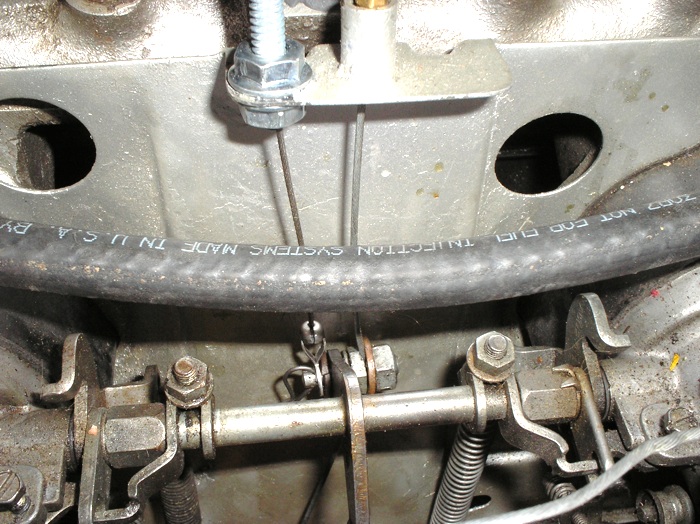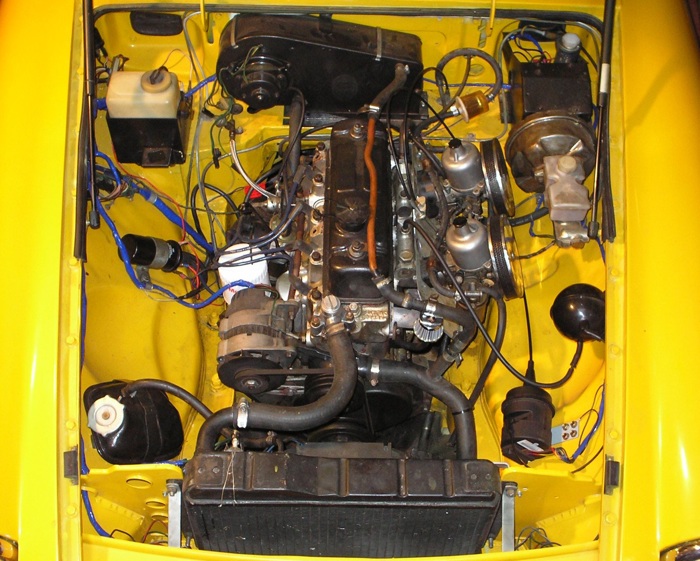First, go buy an Audiovox CCS100 universal cruise control, available from Advance Autoparts, Autozone, Amazon, eBay and many other places for $80 - $100 or so. Next, buy an auxiliary vacuum chamber; I bought mine from NAPA for $13, part number BK 7301605.
I fitted mine to a 1979 MGB that has a 1967 engine. Your application may vary slightly but the basics will be roughly the same. The first thing to do is to program the servo unit to your car. This is done using a set of seven dipswitches located under a cover plate on the end of the unit.
There are two ways to install the cruise: one is to connect it to the coil, the other is to mount a set of magnets on the drive shaft to measure speed. I used the coil connection and this is what I will cover here.
First, remove the cover plate on the end of the unit and set the dipswitches this way:
1 ~ ON 2 ~ ON 3 ~ OFF 4 ~ OFF 5 ~ ON 6 ~ OFF 7 ~ ON
If you should decide to use the magnets on the drive shaft, although I really don’t see any reason why you would since this makes installation much more complicated, the switches need to be set this way:
1 ~ OFF 2 ~ OFF 3 ~ OFF 4 ~ OFF 5 ~ ON 6 ~ OFF 7 ~ ON
You also have to remove a small jumper mounted next to the dipswitches to tell the unit you have a manual car. If - for some reason - you happen to have an auto box leave the jumper in place. Note, these settings differ from the suggested settings in the directions, but they are the ones that seem to work best with MGs.
Once you have set the switches, plug the wiring harness that comes with the kit into the unit and put the cover back on. Then you have to find a place to mount the servo unit. I mounted mine on the left hand inner fender just behind the radiator. On chrome bumper cars you can mount the unit in front of the radiator supports. And some people mount the units under the dash to hide them and keep everything looking stock. The choice is yours; all you need is a place that will allow you to run the cable with no tight curves or kinks.
I wrapped the wiring with blue harness tape to match the existing wiring and ran it along and under the fender edge to a spot just behind the brake booster.
From here you follow the factory instructions for the most part. The blue wire runs across the engine bay and plugs into the negative side of the coil - this is your tachometer take-off. The brown, yellow and green wires need to be fed through the firewall for connection to the switch. The red wire needs to connect to a switched 12V source. The easiest one is the hot wire on the brake light switch. The purple wire then needs to be connected to the side of the brake light switch that is live when the brake pedal is pressed - this is what shuts the cruise off when you hit the brakes (the cruise will also shut off if you hit the clutch, allowing the revs to rise by 500rpms). There is a single, short, black wire that needs to connect to ground, and I connected it to one of the servo mounting screws.
The black and grey pair wires are only used on newer cars or if you are using the magnet kit. They can be taped back or cut off (I taped them back in case I ever move the unit to another vehicle and need them).
Now comes the switch mounting. I chose to put mine on the dash in easy reach, but I have seen them mounted in the ashtray on hidden installations - it’s your choice. My switch was actually mounted over a vacant switch hole allowing easy running of the wires. Once you have chosen your location connect the brown, yellow and green wires to the same colours on the servo using the supplied plastic plug. The red-fuse-orange wire needs to be connected to a switched 12v source, and the grey wire supplies power to the switch lighting. I chose just to connect it to a switched 12v source, but you can connect it to the dash lighting if you like. The black wire is connected to ground.

Audiovox CCS100 universal cruise control switch mounted on MGB dash
That’s it for the wiring, but now you have to connect the cable to your throttle linkage. The unit comes with a huge variety of connectors and mounting brackets. On my HS4s I just drilled a hole in the top of the heat shield next to the existing cable, fed the cable though it, put a supplied loop on the end of the cable, and put it on the same pin that holds the throttle cable.

Cruise control kit linkage to MGB throttle cable/gas pedal
The final part is the vacuum connection. This must come from a source that has a good vacuum at idle. I was fortunate to have a spare vacuum take-off on my inlet manifold, but you may need to do a little drilling and tapping to put a vacuum port on your manifold. The vacuum port on your carburetors will not work because it has no vacuum at idle.
The vacuum port is then connected to the vacuum chamber, which is then connected to the servo unit.

Cruise control kit vacuum chamber and servo (bottom right), connected to MGB engine inlet manifold
And that’s it! These instructions, in conjunction with the instructions supplied with the kit, will make installing cruise control on an MG very simple.
















Want to leave a comment or ask the owner a question?
Sign in or register a new account — it's free